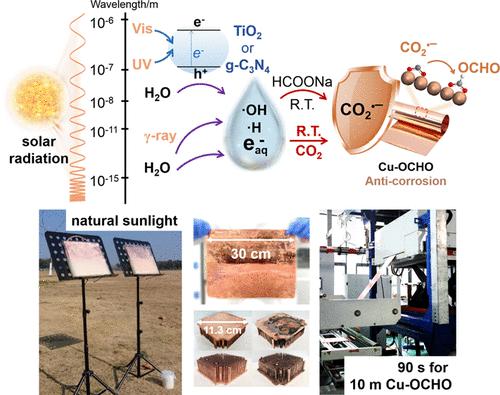当前位置:
X-MOL 学术
›
ACS Mater. Lett.
›
论文详情
Our official English website, www.x-mol.net, welcomes your
feedback! (Note: you will need to create a separate account there.)
Durable Oxidation-Resistance of Copper via Light-Powered Bidentate Binding of Carbon Dioxide Anion Radicals
ACS Materials Letters ( IF 9.6 ) Pub Date : 2022-09-08 , DOI: 10.1021/acsmaterialslett.2c00624 Zhiwen Jiang 1 , Maolin Yu 2 , Shuiyan Cao 3 , Ming Li 4 , Yanpeng Liu 2 , Yunlong Wang 1 , Zhuhua Zhang 2 , Wanlin Guo 2 , Jun Ma 1
ACS Materials Letters ( IF 9.6 ) Pub Date : 2022-09-08 , DOI: 10.1021/acsmaterialslett.2c00624 Zhiwen Jiang 1 , Maolin Yu 2 , Shuiyan Cao 3 , Ming Li 4 , Yanpeng Liu 2 , Yunlong Wang 1 , Zhuhua Zhang 2 , Wanlin Guo 2 , Jun Ma 1
Affiliation

|
Introducing the durable oxidation resistance of refined copper on a large scale while retaining valuable physical properties has great operational and economic benefits for everyday industry but remains a challenge. Here, we report a strategy for the preparation of antioxidant copper under ambient UV/visible or high-energy irradiation using surface-coordinated carbon dioxide anion radicals (CO2•–). It is shown that effective adsorption of CO2•– on copper leads to further formation of bidentate formate multilayers, which hardly degrades surface characteristics but is resistant to chemical attack from a range of highly corrosive solutions such as H2O2, NaCl, Na2S, and NaOH. Due to the universality of free radical production, the anticorrosion procedure requires no high temperature and pressure, as well as the specific container, enabling the processing of various sizes and shapes of copper materials. In addition, we demonstrated several practical advantages: the passivation of different shapes can be easily achieved under natural sunlight; using an industrial electron beam, 10 m oxidation-resistant copper foil can be made in only 90 s. The antioxidation method can use waste CO2 as CO2•– source, thus opening up a complementary opportunity for CO2 immobilization.
中文翻译:

通过二氧化碳阴离子自由基的光动力二齿键结合铜的持久抗氧化性
大规模引入精炼铜的持久抗氧化性,同时保留有价值的物理特性,对于日常工业来说具有巨大的运营和经济效益,但仍然是一个挑战。在这里,我们报告了一种在环境紫外线/可见光或高能辐照下使用表面配位的二氧化碳阴离子自由基 (CO 2 •– ) 制备抗氧化剂铜的策略。结果表明,CO 2 •–在铜上的有效吸附导致进一步形成双齿甲酸盐多层,这几乎不会降低表面特性,但可以抵抗一系列高腐蚀性溶液如 H 2 O 2、NaCl、Na的化学侵蚀2S 和 NaOH。由于自由基生产的普遍性,防腐程序不需要高温和高压,以及特定的容器,可以处理各种尺寸和形状的铜材料。此外,我们还展示了几个实际优势:在自然阳光下可以轻松实现不同形状的钝化;使用工业电子束,只需 90 秒即可制成 10 m 的抗氧化铜箔。抗氧化方法可以利用废CO 2作为CO 2 •–源,从而为CO 2固定化开辟了互补的机会。
更新日期:2022-09-08
中文翻译:

通过二氧化碳阴离子自由基的光动力二齿键结合铜的持久抗氧化性
大规模引入精炼铜的持久抗氧化性,同时保留有价值的物理特性,对于日常工业来说具有巨大的运营和经济效益,但仍然是一个挑战。在这里,我们报告了一种在环境紫外线/可见光或高能辐照下使用表面配位的二氧化碳阴离子自由基 (CO 2 •– ) 制备抗氧化剂铜的策略。结果表明,CO 2 •–在铜上的有效吸附导致进一步形成双齿甲酸盐多层,这几乎不会降低表面特性,但可以抵抗一系列高腐蚀性溶液如 H 2 O 2、NaCl、Na的化学侵蚀2S 和 NaOH。由于自由基生产的普遍性,防腐程序不需要高温和高压,以及特定的容器,可以处理各种尺寸和形状的铜材料。此外,我们还展示了几个实际优势:在自然阳光下可以轻松实现不同形状的钝化;使用工业电子束,只需 90 秒即可制成 10 m 的抗氧化铜箔。抗氧化方法可以利用废CO 2作为CO 2 •–源,从而为CO 2固定化开辟了互补的机会。































 京公网安备 11010802027423号
京公网安备 11010802027423号